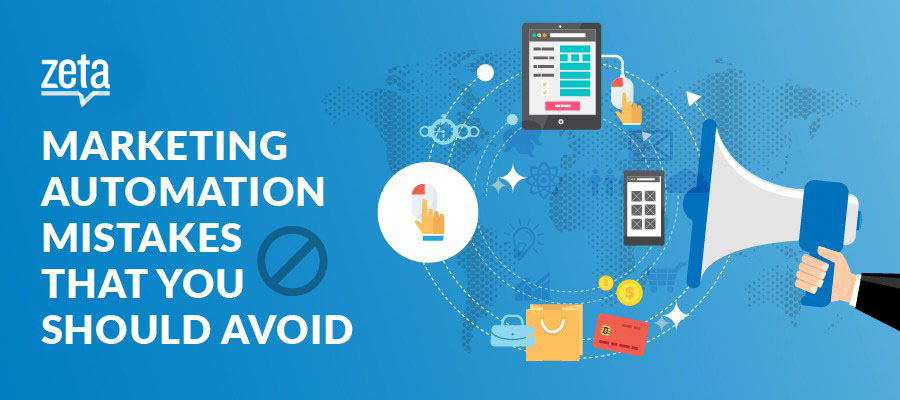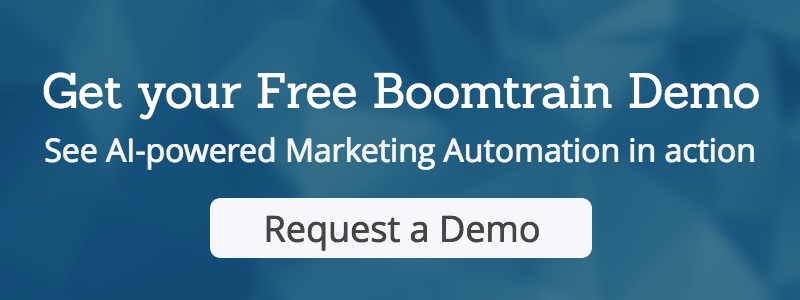
Marketing Automation Mistakes That You Should Avoid
I have been writing about Marketing and Sales niches for over 3 years now. During the course of this time, I have seen numerous brands utilizing the power of Marketing Automation to streamline their sales and marketing efforts. .
At the same time, I have also noticed how under-utilized it is as a discipline. Open any B2B or B2C website and you’ll find all kinds of lead magnets – from simple sign-up prompts to highly targeted messengers and light box messages. However, most of these communications are below par at best when it comes to execution and usefulness
Scattered emails and push messages, irrelevant product and content recommendations, random support tickets, the list goes on and on.
Businesses should consider Marketing Automation as an investment. If you implement it strategically, you might not just get back the principal amount you invested but a hefty interest as well!
Marketing Automation can play an important role in your business, provided you do not under-utilize it.
If you want to setup your automation efforts to yield proper results, make sure that you do not make the following mistakes:
Marketing automation mistakes that most marketers fail to notice
Failing to segment visitors into users, prospects and readers
This is quite a common issue faced by marketing automation beginners. They fail to understand that segmentation of visitors is crucial before setting up automation rules.
Here’s how you should ideally segment your website/app visitors –
- User/Customer – A visitor who lands on your website, learns about your services, looks at your product’s page and its features, reads a few blog articles and then signs up. It can also be a direct sign up without much activity.
- Prospect or lead– A visitor that might visit your website, go through the same flow but does not sign-up for your product or services immediately. Instead he or she might, download an eBook by entering contact details like name, phone number and email address. Or, maybe he/she signs up for your newsletter.
- Reader (Plain-visitor) – Generally this constitutes a majority of visitors on your website. They either land on your website via organic search or through social media channels or other referral websites. They are on your website to look for something specific, read it and leave. In most instances it might take them a couple of weeks or months to come back to your website. These users can be classified as readers.
The different kinds of users who land on your website can be further segmented. For example, prospects can be segmented as –
- Hot Prospects – Prospects who sign up with you soon after their initial interactions with your customer facing channels (website, mobile app etc). These prospects have a higher chance of becoming your customers since they have shown interest in your products/services. The time period to close these deals are fairly short; in most cases, it is under a month. Hence, they must be prioritized above other incoming prospects.
- Cold Prospects – On the other hand, cold prospects are the folks who have been on your website or have used your mobile app multiple times, have signed up for a newsletter, but haven’t engaged with your communications over a considerable amount of time. Such prospects require better targeting via marketing collateral like email, social media interaction and other offerings. The process is called Lead Nurturing.
Bottom line – It is very important to use your marketing automation platform to segment your users. Most platforms provide user segmentation as one of their primary features.
Wanna do one better? Read – Personalization is meant to perfect your user segments.
Email Marketing Automation: You don’t segment your email list
This pointer is like an extension of our previous point. Since, email marketing on it’s own is a big deal for most businesses, we thought it deserved its own section.
Email is arguably the most integral part of a marketing automation software. The very first thing you do when you start using email as a source of reaching out to your users or prospects, is building an email list. Without a strong email list, you can’t build a consistent flow of new users. Moreover, email marketing provides opportunities to upsell and cross-sell to your existing customers.
Let’s say, you do have a strong email list but still are not able to achieve the desired results. Can you guess why?
Well, probably because you might not be segmenting your email list properly, or for that matter, not at all. As a result, your leads might be dropping out of the funnel as they find your emails generic and useless in addressing the problems they face.
Let’s discuss how we can solve this problem.
The Solution:
Develop an email list building strategy which includes email list segmentation so that you’re able to send targeted messages to your leads.
There a 2 major ways in which you can implement email list segmentation –
Use Rule-based targeting to segment your email lists – Traditional marketing automation softwares use rule-based targeting to segment your email lists. You or someone from your team will set up rules – like number of user sessions, number of pages visited, landing page, exit page. Based on these rules, the MA service will allot a segment to the prospect if he or she opts in to your email list. The con of this method is that, a marketer has to constantly monitor and change the rules for optimal results.
AI Based Targeting to segment your email list on the fly – Modern marketing automation services like Boomtrain, use AI and machine learning to segment your email list. This is a far more effective method than the one we discussed above. It takes away all the heavy lifting that marketers have to do to segment users. Instead the rules are set by the AI engine that monitors user activity on all customer-facing channels as well as inside your product (web and mobile).
With the right marketing automation tactic, you can easily segment your email list and expect substantial improvement in your conversion and user engagement rate.
Bonus: 70+ Email Marketing Resources you Should Not Miss
Irregularity at optimizing your automation strategy
Standard turnkey marketing automation SaaS requires continuous monitoring by marketers. Maybe your marketing automation flow works the way you want it to. Even then, it does not mean that it will work the same way 3-6 months down the line. User-behaviour keeps on changing and is considered volatile in modern marketing.
Hence, you need to constantly monitor all the efforts that you make by regularly keeping on eye on –
- User reports and analytics
- Email marketing reports
- User web activity
- Lead scores
- Product usage
Marketers who are new to automation think that the concept is magical and will take care of itself once the initial automation flow has been set up. This is far from the truth. You need to constantly monitor your automation process to achieve desired results.
Note: You can use an AI and machine learning marketing engine like Boomtrain to optimize your marketing strategy on the fly without any assistance. Click here to learn more.
Your sole focus is on Lead Nurturing
One of the most common mistakes done while using automation services is, forgetting about user engagement and going all out with lead nurturing programs. Even seasoned veterans in marketing automation are prone to this oversight.
Most organizations feel that getting new customers is far more important than increasing engagement with existing customers.
Here is a great article on Forbes that argues on the same lines – Selling to existing customers leads to profitable growth.
Customer engagement is as important as lead nurturing, if not more. Providing a stellar customer support by using marketing automation could result in promising rewards like –
- Upselling and cross-selling opportunities
- Word-of-mouth promotion and consumer advocacy
- Higher rate of customer retention and loyalty
You send far too many emails
Perhaps you are of the mindset that a large number of emails to your subscribers is one of the best ways to achieve desired results. But, in reality this is just annoying and sending your leads away from.
DON’T DO THIS!
When it comes to your email list, always focus on providing useful information to your leads. It’s way better to have a low email count that is useful to the readers than a high count that does not provide any handy information.
Try to send out emails that you feel provide true value to your customers. It can be a welcome series that guides new customers on how to use your product, or a series of blog posts that explain how to build supporting strategies
It’s not just about automating your email marketing efforts
Most marketing automation services are good at email marketing. Even though marketers know that MA services are mix of different marketing functionalities, they still focus only on email marketing automation.Let me tell you, other channels are as important as email marketing.
If you concentrate on just one bit, you are failing to provide your customers a consistent and seamless experience. On the other hand if you are able to provide a similar experience over different customer channels(like email, mobile and web), you are increasing the chances of improving your customer engagement and conversion ratio.
Bonus: Read about creating an Omnichannel approach to Marketing Automation.
It will also help you address the diverse nature of your customers. For example, 30% of your customers might be mobile first users of your product. Reaching them on email is not going to be as effective as mobile push and in-mobile communication.
Not testing your Marketing Automation Flow
It’s pretty common that your first few automated flows will have errors or won’t behave as you expect them to. That’s why it is extremely important that you test your automation flow before deploying it.
You can either test your marketing automation flow with limited users from your database or use it with your colleagues on your test account. It might delay your marketing automation implementation by a week to a month. But at least you’ll correct all the possible anomalies in the automation flow.
Here are few important things you should check before deploying it publicly for all your customers –
- Message flow and channel targeting
- Email Design and appearance on various devices
- Behavior based triggers in the flow
- Deliverability and compatibility
Not having a clear goal for your marketing automation strategy
If you deploy multiple automation flows without a clear goal in mind, you end up frustrating yourself and your customers.
Note down clear goals for the efforts, like social media, email marketing, in-app communication etc.
For example: Chowhound deployed marketing automation with the goal of increasing email engagement by a certain amount with a clear workflow in mind. These goals were achieved by segmenting and personalizing email experience for each and every reader that came to their website and subscribed to their newsletter.
End Result:
Using Boomtrain, Chowhound sent out more than 1.2 million emails over a period of around 3 months. Chowhound saw a clear lift in engagement:
- 2.5x higher click-to-open rate for users receiving personalized content vs. popular content
- 28 percent better open rate across personalized emails.
Wrapping Up
Marketing Automation can feel complex and intimidate most marketing rookies. These are just a few major mistakes that marketers commit and I’m pretty sure there are more..
Which brings us to the end of this post. There are few things we would like to know from our readers as well.
We would like to hear what are the challenges that you face when it comes to Marketing Automation? What are the marketing automation mistakes you might think are blasphemous and should be dealt with immediately. Please share your insights and comments in the section below or tweet to us @Boomtrain.



